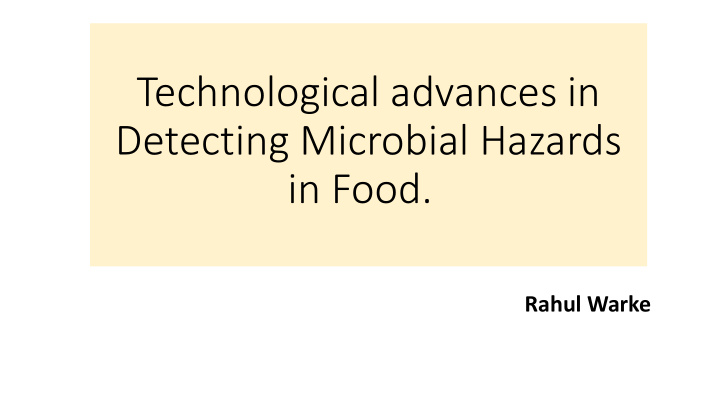



Technological advances in Detecting Microbial Hazards in Food. Rahul Warke
Microbial Hazards • Survival and growth of microorganisms in food processing environments may lead to contamination of the finished product that may, in turn result in a reduction of microbiological safety and quality causing a variety of illness and diseases. • Testing has a very intrinsic role to play in ensuring food safety and in detecting microbial hazards.
Not all ��i�ro�ial� testi�g is the sa�e. Three types of testing: • Traditional batch testing. • Environmental testing. • Process control testing for verification.
Time is money.. …... Technological Advances : Rapid Methods : • Methods for detection, identification and enumeration of microorganisms offer savings in both time and labor.
Tests: • Sample Preparation • Enumeration. • Viable cell counts • Detection • Presence or absence • Identification • To confirm if hazardous or non hazardous.
Advances in Viable Cell Counts. • Total Viable count a successful test to gauge • Sanitary quality • Organoleptic acceptability • Adherence to good Manufacturing practices. • An indication of Safety. Classical test: • Pour Plate Techniques. • Surface or Spread Plate Method. • Membrane Filtration
Newer Techniques: • Spiral Plating: • Reduces human error. • Consistency in results. • Automation in reading and platting. • Petrifilm • Reduced Labour costs and time. • Consistent and accurate results. • User friendly.
• Redigel • Pectin based gels. • Saves time. • Convenient for use • Simplate • Rapid Enumeration of Total Aerobic Bacteria • Reduced test costs.
Identification • Biochemical and Enzymatic methods: • Use of Metabolic activity of microorganisms for identification purpose. Automated systems: • API sytems. • BD Crystal ID system. • Biolog • Micro ID. • VITEK • HiBioID.
• Antibody-Based Methods: • ELISA : • VIDAS : 45 mins to 2 hrs. • Reliable and convenient. • Read and interpreted by machines • Lateral Flow Technology: • Simple to use • Results can be available within 15 minutes • Low cost with no requirement for additional equipment • Stable and robust in storage • Immuno-magnetic seperation (IMS)
Chromogenic Media: Conventional Media Chromogenic Media Sample Sample ↓ ↓ Pre-Enrichment (24 hrs) Pre-Enrichment (24 hrs) ↓ ↓ Selective Enrichment (24 hrs) Direct streaking on chromogenic media (24-48 hrs) ↓ ↓ Isolation (24-48 hrs) Biochemical identification (For further confirmation) 1. General Media 2. Selective Media ↓ Biochemical Identification (24-48 hrs)
Nucleic acid based Methods: • Polymerase Chain Reaction (PCR) • Amplification of target DNA and detection of target PCR products. Most Popular brands for PCR based products: BAX, TaqMan, Molecular Beacon, Invitrogen, Cephid, Qiagen and Applies Biosystems. Features: • Validated and accurate. • Extremely expensive. • Closed systems.
Open Systems. Collection of Food Homogenization of Sample of Interest Sample Enrichment Procedure
Sa�e Day ‘esults… PCR Machine PCR Series Template Extraction Mini-prep or 96 well Format (DNA Extraction or Heat Lysis)
FOOD PATHOGEN DETECTION - Prima-96 Salmonella spp. Detection by Heat Lysis Milk Powder Co��lusio�: No A�plifi�atio� see� i� �No� - Spiked� sa�ples. �Spiked� Sa�ples �ould �e a�plified.
Environmental testing or Hygiene monitoring: • Environmental swabs. • Traditionally used for checking surface contamination. • ATP Bioluminescent Assay swabs. • Instant results. • Organic matter interference. • Prohibitive costs.
M1353 HiCrome UTI Agar For presumptive identification, differentiation and confirmation of microorganisms mainly causing urinary tract infections. It can also be used for testing water, food, environmental & other clinical samples The medium contains two chromogens which detects b -glucosidase and b -D-galactosidase . • Enterococci possesses the enzyme b -glucosidase – blue-green colonies • Escherichia possesses the enzyme b -D-galactosidase – purple-magenta colonies further confirmation by DMACA • • reagent • Coliforms possesses both the enzymes – blue coloured colonies. • Proteus species – brown coloured colony due to tryptophan deaminase activity. • Staphylococcus and Pseudomonas do not possess either of the enzyme , hence forms golden yellow and • colourless colonies respectively. • 1 Prepared medium: Light amber coloured clear to slightly opalescent gel. 2 1) P. mirabilis (ATCC 25933)- Light brown 3 2) E. coli (ATCC 25922)- pink-purple 4 3) E. faecalis (ATCC 29212)- blue, small 4) K.pneumoniae (ATCC 13883) - blue, mucoid
Total Time Taken for Detection PRIMA Series : 15-19 hours Pal� PC‘™ 14 -18 hours Cost per test INR 200
Fung’s Ten Predictions for Food microbiology from 1995 to 2015 are: 1. Viable cell counts will still be used 2. Real-time monitoring of hygiene will be in place 3. PCR, Ribotyping and genetics test will become reality in food laboratories 4. ELISA and immunological tests will be completely automated and widely used. 5. Dipstick technology will provide rapid answers 6. Biosensors will be in place for HACCP programs 7. Instant Detection of target pathogen will be possible 8. Effective separation, concentration of target cells will greatly assist in rapid identification 9. Microbiology alert systems will be in food packages 10. Consumers will have rapid alert kits for pathogens at home.
Recommend
More recommend